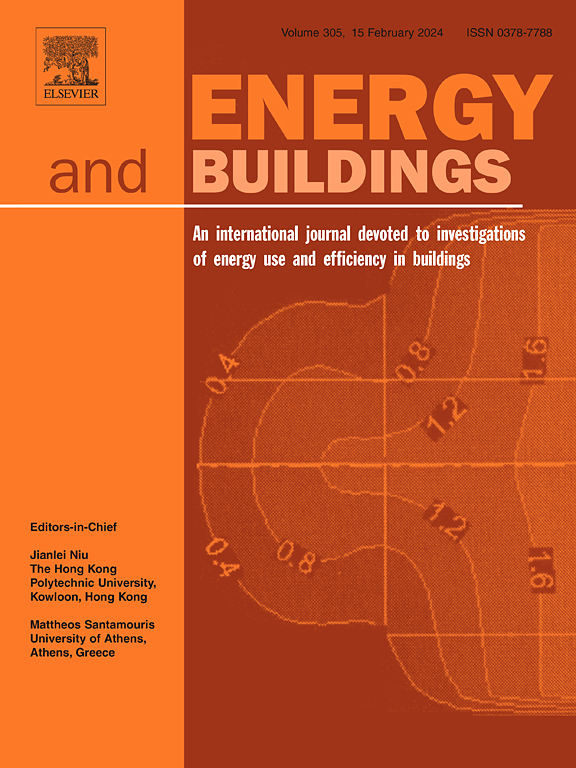用矿渣和粉煤灰增强纸浆污泥/石膏复合材料的相变材料,用于节能建筑:太阳能热调节、能源体现、可持续性指数和成本分析
IF 6.6
2区 工程技术
Q1 CONSTRUCTION & BUILDING TECHNOLOGY
引用次数: 0
摘要
本研究的重点是一些工业废料在创新建筑材料开发中的再利用,以及在相变材料浸渍情况下开发的石膏复合材料的热性能、环境影响和成本估算。将月桂醇(LA)按重量浸渍到纸浆污泥(PPS)中,浸渍率高达 45%,且无渗漏,从而获得形状稳定的复合材料。在石膏复合材料中,用重量百分比为 50% 和 100% 的 PPS 取代经 LA 浸渍的 PPS(PPS/LA)。研究了形状稳定复合材料的特性。此外,还对生产的石膏复合材料的物理、机械、热性能和太阳能热调节测试进行了研究,并进行了体现能源、二氧化碳排放和成本分析。研究发现,PPS/LA 的熔化焓和凝固焓为 100.4-100.1 J/g,在循环 500 次后,潜热储存能力仅降低 0.5%,在循环 1500 次后,降低约 3%。虽然 PPS/LA 在石膏复合材料中的存在会导致抗压强度略有下降,但它显著改善了太阳能热调节性能,使夜间环境温度保持在 2.55 °C 至 5 °C 之间,白天环境温度保持在 5.3 °C 至 13.8 °C 之间。含有 PPS/LA 的石膏复合材料为高能效的可持续建筑应用提供了一个合适的替代方案,它重复利用了约 57% 的三种不同的工业废料,提供了一种减少废物的环保方法和高水平的室内热舒适度。本文章由计算机程序翻译,如有差异,请以英文原文为准。
Phase change material incorporated paper pulp sludge/gypsum composite reinforced by slag and fly ash for energy efficient buildings: Solar thermal regulation, embody energy, sustainability index and cost analysis
This study focuses on the reuse of some industrial wastes in the development of innovative building materials and the thermal performance, environmental impacts and cost estimates of the gypsum composite material developed in the case of a phase change material impregnation. Lauryl alcohol (LA) was impregnated into paper pulp sludge (PPS) up to 45 % by weight without leakage to obtain shape-stable composites. The LA impregnated PPS (PPS/LA) was replaced with PPS at 50 % and 100 % by weight in gypsum composite. Characteristics of shape-stable composites were studied. Also, the physical, mechanical, thermal properties and solar thermoregulation tests of the produced gypsum composites were examined in addition to the embodied energy, CO2 emissions and cost analysis. The melting and solidification enthalpies of PPS/LA were found to be 100.4–100.1 J/g, with only a 0.5 % reduction in latent heat storage capacity after 500 cycles, and approximately 3 % after 1500 cycles. Although the presence of PPS/LA in the gypsum composite caused a slight decrease in compressive strength, it significantly improved solar thermoregulation performance, maintaining ambient temperatures 2.55 °C to 5 °C warmer at night and 5.3 °C to 13.8 °C cooler during the day. Gypsum composites containing the PPS/LA offer a suitable alternative for energy-efficient sustainable building application by reusing around 57 % of three different industrial wastes providing a waste-reducing environmental approach and a high level of indoor thermal comfort.
求助全文
通过发布文献求助,成功后即可免费获取论文全文。
去求助
来源期刊

Energy and Buildings
工程技术-工程:土木
CiteScore
12.70
自引率
11.90%
发文量
863
审稿时长
38 days
期刊介绍:
An international journal devoted to investigations of energy use and efficiency in buildings
Energy and Buildings is an international journal publishing articles with explicit links to energy use in buildings. The aim is to present new research results, and new proven practice aimed at reducing the energy needs of a building and improving indoor environment quality.
 求助内容:
求助内容: 应助结果提醒方式:
应助结果提醒方式:


